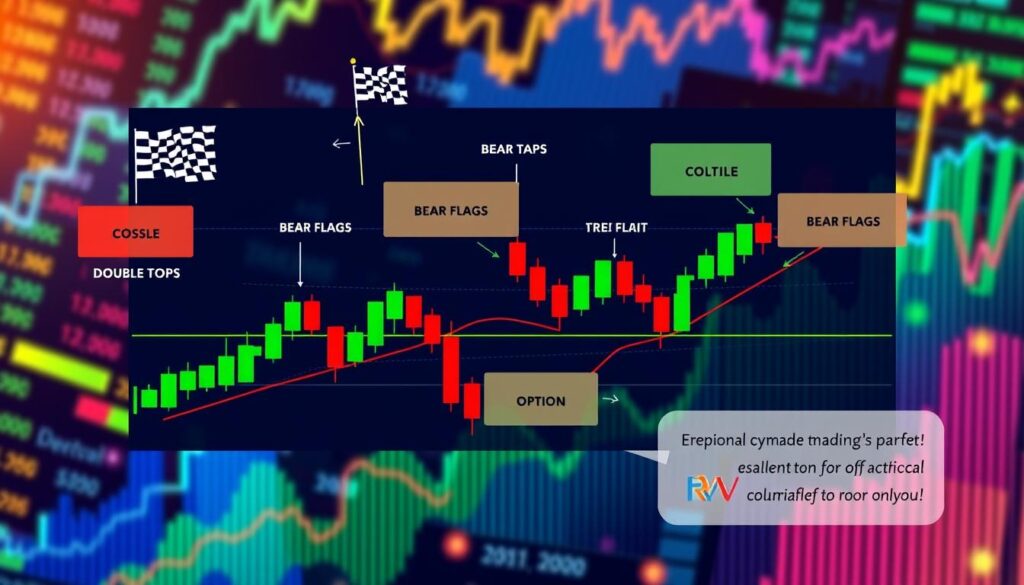Options trading can seem intimidating to new investors, but with the right approach, it can be a powerful tool for making money and managing risk in financial markets. As a beginner, it’s essential to understand the basics of options trading and how it can be an attractive investment strategy. This beginner’s guide will walk you through the process of mastering options trading, providing you with the knowledge and skills needed to succeed in the financial markets.
With options trading, you can leverage market scenarios and generate income through strategies like covered calls. It’s crucial to invest only a fraction of your capital in options to avoid excessive risks and set stop-loss orders to limit potential losses automatically. By following a careful and informed approach, you can master options trading and achieve your financial goals.
In this guide, we’ll cover the fundamentals of options trading, including call options, put options, and the options chain. We’ll also discuss strategies for success, such as starting small and using tools and resources like Tradetron, which provides automated options trading strategies for an efficient trading process. Whether you’re looking to make money or manage risk, options trading can be a valuable addition to your investment portfolio.
Table of Contents
Key Takeaways
- Options trading can be a powerful tool for making money and managing risk in financial markets.
- Understanding the basics of options trading is essential for beginners.
- Investing only a fraction of your capital in options can help avoid excessive risks.
- Setting stop-loss orders can limit potential losses automatically.
- Options trading offers portfolio protection against market downturns via hedging.
- A beginner’s guide can provide the knowledge and skills needed to succeed in options trading.
- Options trading provides flexibility for leveraging market scenarios compared to stock trading.
Understanding the Basics of Options Trading
Options trading can seem complex, but it’s essential to understand the basics before diving in. An option is a financial contract that gives the buyer the right, but not the obligation, to buy or sell an asset at a specific price before a certain date, known as the expiration date. The price at which the asset can be bought or sold is called the strike price.
There are two main types of options: call options and put options. Call options give the buyer the right to buy an asset, while put options give the buyer the right to sell an asset. For example, if you buy a call option for a stock with a strike price of $50, you have the right to buy the stock at $50 before the expiration date, regardless of the current market price.
Key Concepts in Options Trading
- Options contracts: a financial contract that gives the buyer the right to buy or sell an asset
- Strike price: the price at which the asset can be bought or sold
- Expiration date: the last day the option can be exercised
- Call options: give the buyer the right to buy an asset
- Put options: give the buyer the right to sell an asset
Understanding these key concepts is crucial for successful options trading. It’s also important to note that options trading involves risk, and it’s essential to educate yourself before making any investment decisions.
By grasping the basics of options trading, including options contracts, call options, put options, strike price, and expiration date, you’ll be better equipped to navigate the world of options trading and make informed investment decisions.
| Type of Option | Description |
|---|---|
| Call Option | Gives the buyer the right to buy an asset |
| Put Option | Gives the buyer the right to sell an asset |
Why Consider Options Trading in Your Investment Strategy
Options trading can be a valuable addition to your investment strategy, offering a range of benefits including portfolio diversification and risk management. By incorporating options into your investment portfolio, you can potentially reduce your overall risk and increase your returns. This is because options can be used to hedge against market downturns, protecting your investments from significant losses.
One of the key advantages of options trading is that it requires less capital than equivalent stock transactions, making it a more accessible option for many investors. Additionally, options can be used to generate income, speculate on price movements, or hedge against potential losses. With the right risk management techniques in place, options trading can be a powerful tool for achieving your investment goals.
Some common options trading strategies include:
- Covered calls
- Protective puts
- Spreads
- Long straddles and strangles
These strategies can be used to achieve a range of objectives, from generating income to speculating on price movements. By understanding how to use these strategies effectively, you can make more informed investment decisions and potentially increase your returns.
Ultimately, options trading can be a valuable addition to your investment strategy, offering a range of benefits including portfolio diversification and risk management. By understanding how to use options effectively, you can make more informed investment decisions and potentially increase your returns.
| Strategy | Description |
|---|---|
| Covered Call | Buying the underlying stock and selling a call option |
| Protective Put | Buying a put option to hedge against a potential loss |
| Spread | Buying one option and selling another with a different strike price or expiration date |
The Structure of Options Contracts
Understanding the options contract structure is crucial for successful options trading. This structure includes the strike price, expiration date, and contract multiplier, all of which affect the value of the option. The strike price is the price at which the underlying asset can be bought or sold, and it is a key factor in determining the option’s value.
The expiration date is the last day on which the option can be exercised, and it is also an important factor in the options contract structure. As the expiration date approaches, the option’s value decreases due to time decay. The contract multiplier, on the other hand, determines the number of underlying assets that the option contract covers.
For example, a standard options contract for stocks usually covers 100 shares. The buyer of a call option pays the option premium in full at the time of entering the contract, and the potential profit is calculated considering the difference between the selling price and the buying price of the stock. The net profit for the call buyer is determined by subtracting the premium paid for the option from the realized profit. Options trading allows investors to control a large amount of a stock or other underlying asset through a relatively small premium, offering increased speculative prospects.
Here is a summary of the key components of the options contract structure:
- Strike price: the price at which the underlying asset can be bought or sold
- Expiration date: the last day on which the option can be exercised
- Contract multiplier: determines the number of underlying assets that the option contract covers
- Time decay: the decrease in the option’s value as the expiration date approaches
By understanding these components and how they interact, investors can make informed decisions about their options trading strategies and maximize their potential profits.
Essential Tools for Options Traders
Options trading involves making informed decisions based on market analysis and risk management. To achieve this, traders rely on options trading platforms that provide real-time data, analysis tools for charting and technical analysis, and risk management software to minimize losses. Platforms like Tradetron allow users to create their own options strategies or use available ones for more efficient trading.
Some key features of these platforms include customizable charting functions, technical analysis alerts, and educational resources. For instance, Trading Central offers integrated technical analysis tools, while Fidelity’s Active Trader Pro provides screening tools that filter stocks and ETFs based on technical criteria.
Traders also utilize risk management software to set stop-loss orders, manage position sizing, and diversify their portfolios. This software helps in mitigating potential losses and maximizing gains. By combining options trading platforms, analysis tools, and risk management software, traders can develop a comprehensive strategy for success in the options market.
When choosing these tools, it’s essential to consider factors such as commission structures, platform features, and the level of customer support. With the right combination of options trading platforms, analysis tools, and risk management software, traders can navigate the complex world of options trading with confidence.
Understanding Options Pricing and Greeks
Options pricing is a complex concept that involves various factors, including the underlying asset’s price, volatility, and time to expiration. To better understand options pricing, traders use a set of metrics known as the Greeks, which include delta, gamma, theta, and vega. These metrics help traders assess the risk and potential profit of an options trade.
The Greeks play a crucial role in options pricing, as they measure the sensitivity of an option’s price to changes in the underlying asset’s price, volatility, and time to expiration. Delta measures the rate of change of an option’s price with respect to the underlying asset’s price, while gamma measures the rate of change of an option’s delta. Theta measures the rate of time decay, and vega measures the sensitivity of an option’s price to changes in volatility.
Implied volatility is another important factor in options pricing, as it represents the market’s expectation of future price fluctuations. The following are key points to consider when evaluating options pricing and the Greeks:
- Delta: measures the rate of change of an option’s price with respect to the underlying asset’s price
- Gamma: measures the rate of change of an option’s delta
- Theta: measures the rate of time decay
- Vega: measures the sensitivity of an option’s price to changes in volatility
- Implied volatility: represents the market’s expectation of future price fluctuations
By understanding the Greeks and implied volatility, traders can make more informed decisions when buying or selling options, and develop effective strategies to manage risk and maximize profits.
Developing Your Options Trading Strategy
When it comes to options trading, having a well-thought-out strategy is crucial. This involves understanding your risk tolerance and investment goals, as these will guide your decision-making process. A good options trading strategy should align with your overall financial objectives and risk appetite.
To develop an effective options trading strategy, consider the following factors:
- Understand the different types of options, including call and put options
- Learn about the various options trading strategies, such as long call, long put, and bull call spread
- Assess your risk tolerance and investment goals to determine the best approach for you
A key aspect of options trading is managing risk. This can be achieved by setting clear investment goals and understanding your risk tolerance. It’s also essential to stay informed about market trends and adjust your strategy accordingly. By doing so, you can create a personalized options trading strategy that suits your needs and helps you achieve your financial objectives.
Ultimately, a successful options trading strategy requires a combination of knowledge, experience, and discipline. By taking the time to understand your risk tolerance and investment goals, you can develop a strategy that works for you and helps you navigate the world of options trading with confidence.
Risk Management in Options Trading
Risk management is crucial in options trading due to the potential for significant losses. Effective risk management involves understanding the risks associated with each trade and taking steps to mitigate them. One key aspect of risk management is position sizing, which involves determining the appropriate amount of capital to allocate to each trade.
Another important risk management strategy is the use of stop-loss orders, which can limit the extent of potential losses by automatically closing a trade when the price moves against the trader. Portfolio diversification is also essential, as it involves spreading investments across different asset classes and sectors to minimize risk exposure.
By implementing these risk management strategies, traders can help protect their accounts from significant declines and balance profit potential with risk. The following table highlights the importance of risk management in options trading:
| Risk Management Strategy | Description |
|---|---|
| Position Sizing | Determining the appropriate amount of capital to allocate to each trade |
| Stop-Loss Orders | Automatically closing a trade when the price moves against the trader |
| Portfolio Diversification | Spreading investments across different asset classes and sectors to minimize risk exposure |
Basic Options Trading Patterns
Options trading involves various strategies, including bullish strategies, bearish strategies, and neutral strategies. These strategies are used to predict market movements and make informed trading decisions. Bullish strategies, such as buying calls, are used when a trader expects the market to rise. Bearish strategies, such as buying puts, are used when a trader expects the market to fall. Neutral strategies, such as straddles, are used when a trader expects the market to remain stable.
There are several options patterns that traders use to make predictions. These patterns include continuation patterns, reversal patterns, and bilateral patterns. Continuation patterns, such as ascending triangles, indicate that the current trend is likely to continue. Reversal patterns, such as head and shoulders, indicate that the current trend is likely to reverse. Bilateral patterns, such as symmetrical triangles, indicate that the market is uncertain and may move in either direction.
- Ascending and descending staircases
- Triangles (ascending, descending, and symmetrical)
- Flags (bullish and bearish)
- Wedges
- Double tops and double bottoms
- Head and shoulders
- Rounded tops or bottoms
- Cup and handle
These patterns can be used to predict market movements and make informed trading decisions. By understanding these patterns and using bullish strategies, bearish strategies, and neutral strategies, traders can increase their chances of success in the options market.
Advanced Options Strategies for Growth
As traders gain experience and confidence with basic options strategies, they can explore more advanced techniques to maximize returns. Advanced options strategies, such as spreads, straddles, and iron condor, offer the potential for higher profits but also come with increased risk. These strategies are suitable for traders who have a solid understanding of options trading fundamentals and are looking to expand their skill set.
One popular advanced strategy is the iron condor, which involves selling a call option and buying a call option with a higher strike price, while also selling a put option and buying a put option with a lower strike price. This strategy is designed to profit from a stable market with low volatility. Another strategy is the straddle, which involves buying a call option and a put option with the same strike price and expiration date. This strategy is used to profit from a significant price movement in either direction.
Traders can also use spreads, such as vertical spreads, horizontal spreads, and diagonal spreads, to manage risk and increase potential profits. These strategies involve buying and selling options with different strike prices and expiration dates to create a spread that can profit from various market conditions.
Advanced options strategies can be complex and require a deep understanding of options trading principles. However, with the right knowledge and experience, traders can use these strategies to maximize returns and achieve their investment goals. It’s essential to thoroughly back-test and evaluate these strategies before implementing them in a live trading environment.
| Strategy | Description | Risk Level |
|---|---|---|
| Iron Condor | Selling a call option and buying a call option with a higher strike price, while also selling a put option and buying a put option with a lower strike price | Medium to High |
| Straddle | Buying a call option and a put option with the same strike price and expiration date | High |
| Spreads | Buying and selling options with different strike prices and expiration dates to create a spread | Medium |
Common Options Trading Mistakes to Avoid
Options trading can be a lucrative investment strategy, but it’s not without its pitfalls. Many traders, especially beginners, fall into common traps that can lead to significant losses. By being aware of these options trading mistakes, you can take steps to avoid them and improve your chances of success. One of the most significant mistakes is emotional trading, where fear and greed drive decisions rather than a well-thought-out strategy.
Risk management is another critical area where traders often go wrong. Risk management errors can lead to overleveraging, failing to use stop-losses, and not diversifying your portfolio. This can result in significant losses, even if you’re correct about the direction of the market. A well-planned strategy selection is also essential, as using complex strategies without mastering the basics can lead to confusion and poor decision-making.
Emotional Trading Pitfalls
Emotional trading can lead to impulsive decisions, causing you to buy or sell options at the wrong time. This can result in losses and a significant decrease in your trading capital. To avoid this, it’s essential to develop a trading plan and stick to it, rather than making decisions based on emotions.
Risk Management Errors
Risk management is critical in options trading, as it helps you mitigate potential losses. Common risk management errors include overleveraging, failing to use stop-losses, and not diversifying your portfolio. By avoiding these mistakes, you can reduce your risk and increase your chances of success.
Strategy Selection Mistakes
A well-planned strategy selection is essential in options trading. Using complex strategies without mastering the basics can lead to confusion and poor decision-making. It’s crucial to develop a trading plan and stick to it, rather than trying to use multiple strategies at once.
By being aware of these common options trading mistakes, you can take steps to avoid them and improve your chances of success. Remember to develop a trading plan, stick to it, and continuously educate yourself on the best practices in options trading.
| Mistake | Percentage of Occurrence |
|---|---|
| Emotional Trading | 30% |
| Risk Management Errors | 25% |
| Strategy Selection Mistakes | 20% |
| Lack of Education | 15% |
| Lack of Discipline | 10% |
Reading and Analyzing Options Charts
Options charts are essential tools for traders, providing valuable insights into market trends and potential trading opportunities. Technical analysis of options charts involves examining patterns and trends to predict future price movements. By understanding how to read options charts, traders can make more informed decisions about their investments.
An options chain displays various expiry dates and strike prices for a particular security, allowing traders to compare different options contracts. Each column in the options chain represents a specific piece of information, such as the last price, bid, and ask. By analyzing this data, traders can identify trends and patterns that may indicate potential trading opportunities.
Some key concepts to understand when analyzing options charts include support and resistance levels, which can help traders identify potential entry and exit points. Options charts can also be used to visualize trading activity and identify trends, making it easier to make informed trading decisions. By combining technical analysis with a thorough understanding of options charts and the options chain, traders can develop a comprehensive trading strategy that helps them achieve their investment goals.
Here is a summary of key concepts to keep in mind when analyzing options charts:
- Understand the structure of an options chain and how to read it
- Identify support and resistance levels to inform trading decisions
- Use technical analysis to examine patterns and trends in options charts
- Combine technical analysis with a thorough understanding of options charts and the options chain to develop a comprehensive trading strategy
By following these tips and practicing reading options charts, traders can improve their skills and make more informed investment decisions.
| Concept | Description |
|---|---|
| Options Chain | A table displaying various expiry dates and strike prices for a security |
| Technical Analysis | The study of patterns and trends in options charts to predict future price movements |
| Support and Resistance Levels | Key price levels that can indicate potential entry and exit points |
The Role of Market Analysis in Options Trading
Market analysis plays a crucial role in options trading, as it helps traders make informed decisions about their investments. Technical analysis is a key component of market analysis, involving the study of charts and patterns to predict future price movements. This type of analysis can be used in conjunction with fundamental analysis, which examines economic and financial factors that may impact options prices.
Understanding market sentiment is also essential in options trading. This can be achieved through the use of various indicators, such as the put-call ratio, which measures the volume of put options versus call options. By analyzing these indicators, traders can gain insights into the overall market sentiment and make more informed trading decisions.
- Relative strength index (RSI)
- Moving Average Convergence Divergence (MACD)
- Bollinger Bands
These tools can help traders identify trends, predict price movements, and make more informed decisions about their investments.
| Indicator | Description |
|---|---|
| RSI | Measures the magnitude of recent price changes to determine overbought or oversold conditions |
| MACD | Plots two moving averages to identify trends and predict price movements |
| Bollinger Bands | Consists of a moving average and two standard deviations to measure volatility and identify trends |
Building Your Options Trading Plan
Creating a solid options trading plan is essential for success in the market. This plan should include clear trading goals, an understanding of your risk tolerance, and a well-thought-out strategy selection process. By setting specific, measurable, attainable, relevant, and time-bound (SMART) goals, you can ensure that your trading activities are focused and directed.
A key component of your options trading plan is defining your risk-reward ratio. This ratio will help you determine the potential profit and loss of each trade, allowing you to make informed decisions. It’s also important to consider your risk tolerance when selecting trading strategies and setting position sizes.
When developing your options trading plan, consider the following factors:
- Market analysis and volatility
- Trading style and strategy selection
- Risk management and position sizing
- Record-keeping and trade analysis
By carefully considering these factors and creating a comprehensive options trading plan, you can increase your chances of success in the market. Remember to regularly review and adjust your plan to ensure it remains aligned with yourtrading goalsandrisk tolerance.
With a well-crafted options trading plan in place, you’ll be better equipped to navigate the markets and make informed trading decisions. By combining a solid plan with a thorough understanding of options trading concepts and strategies, you can set yourself up for long-term success in the world of options trading.
Options Trading Platforms and Brokers
When it comes to options trading, choosing the right platform and broker is crucial. With so many options trading platforms and online brokers available, it can be overwhelming to decide which one to use. Commission structures and trading features are essential factors to consider. For example, tastytrade charges $1.00 for options on stocks and ETFs, while Charles Schwab offers $0.65 per option contract.
Some popular options trading platforms and online brokers include Interactive Brokers, Webull, and E*Trade. Each of these platforms has its own unique features and commission structures. For instance, Interactive Brokers provides $0.65 per contract options fees with no stocks, ETFs, and mutual funds fees. Webull stands out with $0.00 fees for stocks, ETFs, and options, and $0.55 for certain option indexes and $1.25 for futures contracts.
Here is a comparison of some popular options trading platforms and online brokers:
| Broker | Options Commission | Stocks and ETFs Commission |
|---|---|---|
| tastytrade | $1.00 | $0.00 |
| Charles Schwab | $0.65 | $0.00 |
| Interactive Brokers | $0.65 | $0.00 |
| Webull | $0.00 | $0.00 |
| E*Trade | $0.65 | $0.00 |
Real-World Options Trading Examples
Options trading can be a powerful tool for investors, offering the potential for significant gains with managed risk. Let’s examine some real-world options trading examples to illustrate how this works. For instance, consider a scenario where an investor buys a call option for a stock with a strike price of $50, and the stock price rises to $60. In this case study, the investor could sell the call option for a profit, or exercise the option to buy the stock at the lower strike price and then sell it at the higher market price.
Another trading scenario involves buying a put option to hedge against a potential decline in stock price. If the stock price does drop, the investor can exercise the put option to sell the stock at the higher strike price, limiting their losses. These options trading examples demonstrate how investors can use options to manage risk and potentially amplify gains. By studying these case studies and trading scenarios, investors can develop a deeper understanding of how to effectively use options in their investment strategy.
Here is a summary of the potential outcomes in these options trading examples:
- Potential profit from buying a call option: $800
- Potential loss reduction from buying a put option: $3,500
- Potential profit from selling a call option: $250
- Potential profit from selling a put option: $300
These trading scenarios illustrate the importance of carefully considering the potential risks and rewards of each trade, as well as the need for a well-thought-out investment strategy. By studying these options trading examples and case studies, investors can gain a better understanding of how to use options to achieve their investment goals.
Conclusion: Your Path to Options Trading Success
As we reach the end of this comprehensive guide, it’s important to remember that mastering options trading is a continuous journey filled with learning and practice. The strategies and insights you’ve explored throughout this article are merely the foundation for your success. The true key lies in your dedication to continuous learning and a disciplined approach to options trading.
Start small, use paper trading to hone your skills, and always prioritize risk management. With patience and the right mindset, you can navigate the dynamic world of options trading and unlock new opportunities for growth and profit. Remember, your trading journey is unique, so embrace the challenges, learn from your experiences, and celebrate your victories, no matter how small.
To further support your options trading endeavors, we encourage you to explore additional resources, attend workshops, and connect with a community of fellow traders. By continuously expanding your knowledge and refining your strategies, you’ll be well on your way to achieving your options trading goals and financial objectives.
FAQ
What are options contracts?
Options contracts are financial instruments that give the holder the right, but not the obligation, to buy or sell an underlying asset at a predetermined price within a specific time period.
What are the main types of options?
The two main types of options are call options and put options. Call options give the holder the right to buy the underlying asset, while put options give the holder the right to sell the underlying asset.
What key terminology do I need to know for options trading?
Some essential options trading terms include strike price, expiration date, contract multiplier, and time value. Understanding these concepts is crucial for navigating the options market.
How can options trading benefit my investment strategy?
Options trading can provide portfolio diversification, leverage, and risk management opportunities. By incorporating options into your investment strategy, you may be able to potentially reduce overall risk and generate higher returns.
What are the different components of an options contract?
Key components of an options contract include the strike price, which determines the price at which the option can be exercised, the expiration date, which is the deadline for exercising the option, and the contract multiplier, which determines the size of the contract.
What tools do options traders use?
Options traders rely on a variety of tools, including trading platforms, analysis software, and risk management software. These tools can help streamline the trading process and make more informed decisions.
What are the “Greeks” in options trading?
The “Greeks” in options trading refer to the sensitivity measures that describe how an option’s price changes in relation to factors such as time (Theta), volatility (Vega), and the underlying asset’s price (Delta and Gamma). Understanding the Greeks is crucial for pricing options and managing risk.
How do I develop an effective options trading strategy?
Developing an options trading strategy involves understanding your risk tolerance, investment goals, and the appropriate strategies for your market outlook. Starting small and gradually building experience is key to finding a personalized approach that works for you.
What are some common options trading mistakes to avoid?
Common options trading mistakes include emotional trading, overleveraging, and using complex strategies before mastering the basics. Maintaining discipline, following a well-designed trading plan, and prioritizing risk management can help you avoid these pitfalls.
How do I choose the right options trading platform and broker?
When selecting an options trading platform and broker, consider factors such as user-friendliness, educational resources, analysis tools, commission structures, and customer support. Choosing the right platform can significantly impact your trading experience and success.









